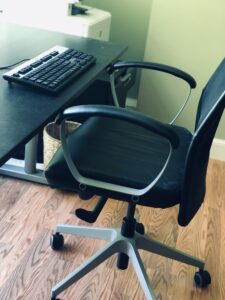 4 QUICK and EASY Ways To Improve Your Desk Set Up
4 QUICK and EASY Ways To Improve Your Desk Set Up
Spending several hours at a desk each day can contribute to musculoskeletal imbalances and potentially symptoms over time. Below are 4 EASY STEPS to help assist with proper workstation ergonomics.
Step 1- Adjust your chair
Feet should rest flat on the floor with buttocks all the way to the back of the chair. Your knees should be slightly below hip height. Elbows should be bent at 90 degrees with shoulders relaxed. You may have to adjust the arm rests on the chair or the desk height to achieve this. Consider a lumbar support pillow if you do not have one built into your chair.
Step 2 – Head and spinal posture
The head should be upright with the chin slightly tucked to allow for a neutral cervical posture. Remind yourself often to pull the shoulders back squeezing the shoulder blades together to reverse a forward slumped posture. Neutral lumbar spine should be maintained by keeping your center of mass over the “sit bones” and engaging your core muscles frequently.
Step 3 – Adjust the monitor
The monitor should be directly in front of you or at a slight (10 degree) angle, roughly 20 inches away from the eyes. Consider a document holder to eliminate stress to the neck.
Step 4 – Mouse and Keyboard
The mouse should rest close to the keyboard. The wrists should be rested in a comfortable neutral position.
Remember to get up and move around every 20-30 min to allow muscles to move out of their rested position.
Keep in mind that although laptops are convenient, they are not suitable for long term use. Consider a laptop stand if you will be using a laptop for extended periods of time.
For increased lumbar support, you can make a lumbar roll using a bath towel. Wrap tape around a rolled bath towel. Position the roll at the base of the lumbar spine adjacent to the belt line. This will help to maintain a natural lordotic curve. You can use this at your desk, in the car or on the airplane to improve posture control and help lessen the force on the lumbar spine.
“Ergonomics is the science of designing the job to fit the worker, rather than physically forcing the worker’s body to fit the job.” – U.S Dept of Labor




